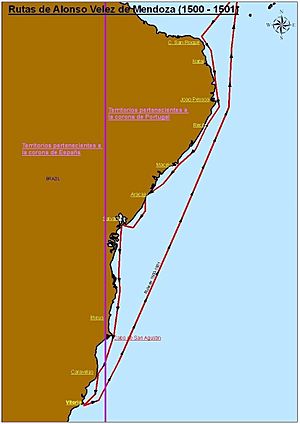Alonso Vélez de Mendoza facts for kids
Alonso Vélez de Mendoza was a Spanish explorer and a member of the Order of Santiago. He was born in Moguer, Spain, in the late 1400s. On June 6, 1499, he received special permission from the King and Queen of Spain, known as the Catholic Monarchs, to sail to the Indies. He was allowed to take four ships, but he ended up using only two small ships called caravels. His goal was to explore the coast of North America or to join the race to explore Brazil.
Exploring New Coasts
By October 1500, Alonso Vélez de Mendoza successfully sailed south of Cape St. Augustine. This was the first time a Spanish ship had gone that far south. He continued his journey down the coast until he reached a river called Cervutos.
His discoveries had two important results:
- First, he showed that Cape St. Augustine was part of a large continent, not an island. This area was in a part of the world claimed by Portugal.
- Second, as he sailed further south, he found that the coast turned southwest. This new area was within the lands claimed by Spain. This opened up many new chances for exploration for Spain.
In May 1501, Alonso Vélez de Mendoza and his crew returned to Seville, Spain. They had not found the southern tip of the continent, which they had expected to be at the same latitude as the Cape of Good Hope in Africa.
Life in the New World
On February 15, 1502, Alonso Vélez de Mendoza received a special agreement. This agreement allowed him to settle on the island of Hispaniola with fifty settlers and their families. His goal was to create a new town there. That same year, a large fleet of thirty other ships arrived in Hispaniola. These ships carried 2,500 more colonists. Among them were Nicolás de Ovando y Cáceres, the new Spanish Governor of Hispaniola, and the famous explorer Francisco Pizzaro. It is believed that Alonso Vélez de Mendoza passed away at the end of 1511.
See also
 In Spanish: Alonso Vélez de Mendoza para niños
In Spanish: Alonso Vélez de Mendoza para niños


